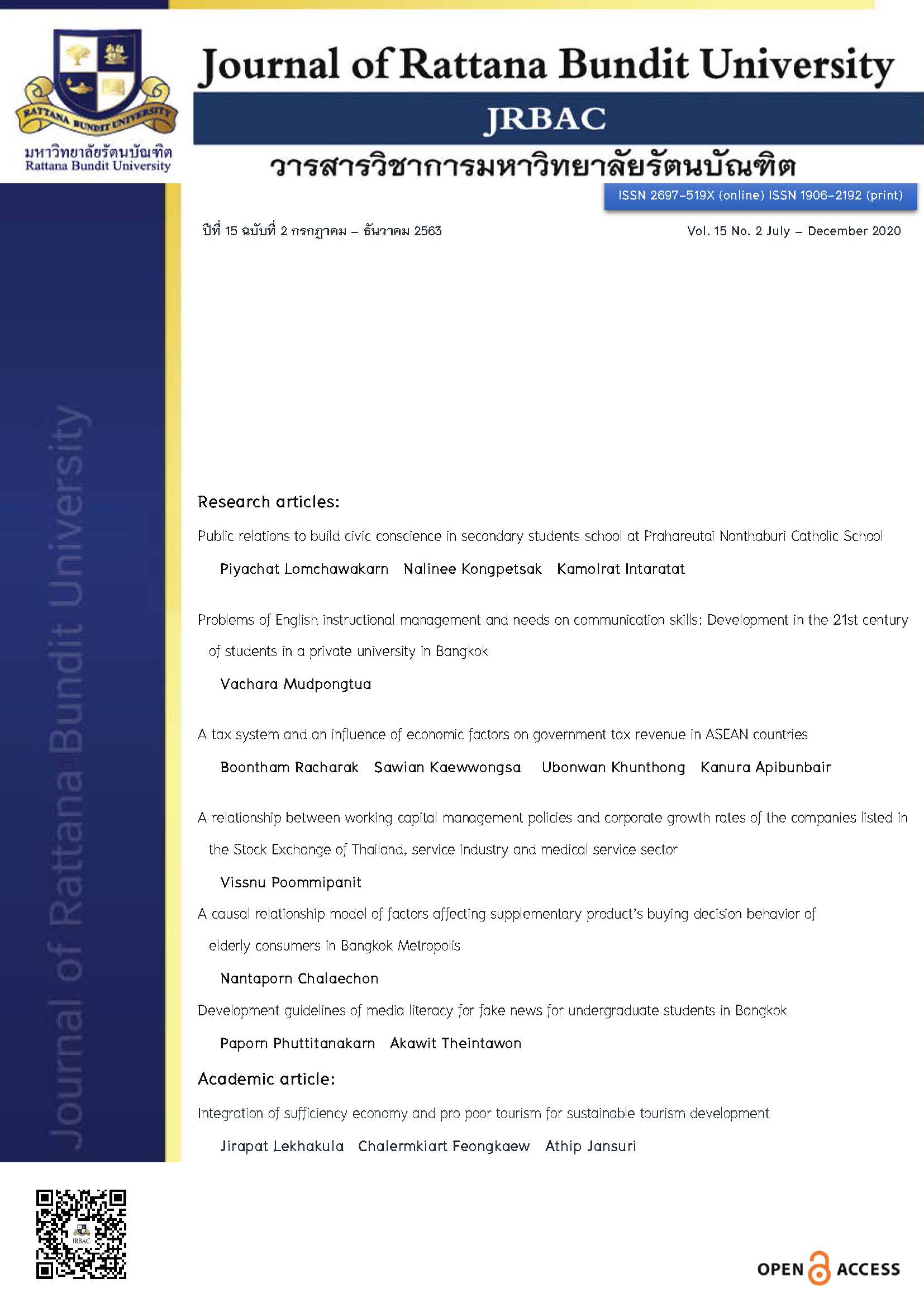Public relations to build civic conscience in secondary students school at Prahareutai Nonthaburi Catholic School
Main Article Content
Abstract
The objectives of this research were to study public relations in building public conscience, exposure to public relations, public conscience behavior, the relationship between the level of exposure to the public relations and public conscience behavior, and recommendations for strategies to produce effective public relations media to develop students’ sense of public conscience. This was mixed-methods research. For the quantitative approach, the sample chosen through a multi-stage sampling population was 300 students. The research tool was a questionnaire. The data were statistically analyzed using Pearson’s correlated coefficient. For the qualitative method, the key informants were the operating head of the volunteer program, the director for pastoral care, and the head of the public relations unit. The research tool was an interview form and data were analyzed with descriptive analysis. The results showed the public relations used a media mix, but the primary medium was personal media i.e. teachers, friends, and personnel, who acted as middlemen transmitting messages to the target audience and encouraging students to participate in public service projects. For media exposure, the media the students were exposed to the most were personal media and the school’s public address system. For public conscience behavior, the students had a high level of personal conscience and public conscience. The level of exposure to public relations was correlated to public conscience behavior. Grade levels affected the level of exposure to public relations and public conscience behavior to a statistically significant degree of 0.05 confidence. Recommendations for effective strategies are to arrange public service activities more quickly, to set plans in advance, and to make the costs for joining public service activities more affordable.
Article Details
References
Apiwatthayasakul, K. (2015). Online public relations. conservation of religion and culture. (in Thai)
คำนาย อภิปรัชญาสกุล. (2558). การประชาสัมพันธ์ทางออนไลน์. จิตสํานึกในการอนุรักษ์ศาสนาและวัฒนธรรม
Chaiyasarn.T. (2010). Public relations strategy and responsible expression to the society of the company's customers Bangkok Expressway Public Company Limited. (Master of Thesis). Sukhothai Thammathirat Open University, Nonthaburi. (in Thai)
ทิมาภรณ์ ไชยสาร. (2553). กลยุทธ์การประชาสัมพันธ์และการรับรู้การแสดงออกซึ่งความรับผิดชอบ ต่อสังคมของกลุ่มลูกค้าบริษัท ทางด่วนกรุงเทพ จำกัด (มหาชน) (วิทยานิพนธ์มหาบัณฑิต). มหาวิทยาลัยสุโขทัยธรรมาธิราช, นนทบุรี.
Chatchakun. N. (2014). Tourism Industry (7th ed.). Bangkok: Chulalongkorn University. (in Thai)
นิศา ชัชกุล. (2557). อุตสาหกรรมการท่องเที่ยว (พิมพ์ครั้งที่ 7). กรุงเทพฯ: วี.พริ้นท์
Wahji, J. (2016). Factors affecting public mental behavior of one secondary school student in Bangkok (Master's thesis). Graduate school, Rambhai Barni Rajabhat University, Chantaburi. (in Thai)
จิตติยา วาจี. (2559). ปัจจัยที่มีผลต่อพฤติกรรมจิตสาธารณะของนักเรียนโรงเรียนมัธยมศึกษาแห่งหนึ่งในเขตกรุงเทพมหานคร (วิทยานิพนธ์มหาบัณฑิต). สาขาสังคมศาสตร์เพื่อการพัฒนา คณะมนุษศาสตร์และ สังคมศาสตร์, มหาวิทยาลยัราชภัฏรําไพพรรณี, จันทบุรี.
Habermas, J. (1992). The structural transformation of the public sphere: An inquiry into a category of bourgeois society. Cambridge: Polity Press.
Kohlberg, I. (1976). Moral stages and moralization: The cognitive-developmental approach. In Lickonr (ed.) Moral development and behavior: Theory, research, and social issues. New York: Holt, Rinehart, and Winson.
Phuaban, B. (2006). The use of puppet theater videos as a model for developing the public mind of Grade students Grade 2 (Master's thesis). Srinakharinwirot University, Bangkok. (in Thai)
บุญทัน ภูบาล (2549) การใช้วีดิทัศน์ละครหุ่นเชิดเป็นตัวแบบเพื่อพัฒนาจิตสาธารณะของนักเรียนชั้นประถมศึกษาปีที่ 2. (วิทยานิพนธ์มหาบัณฑิต). มหาวิทยาลัยศรีนครินทรวิโรฒ, กรุงเทพฯ.
Sutheethorn, B. (2005). Theory of internal and interpersonal communication. In the philosophy of the subject matter Communication Arts and Communication Theory Unit 7. Nonthaburi: Sukhothai Thammathirat Open University. (in Thai)
บุษบา สุธีธร. (2548). ทฤษฎีการสื่อสารภายในบุคคลและระหว่างบุคคล. ในประมวลสาระชุดวิชาปรัชญานิเทศศาสตร์และทฤษฎี การสื่อสารหน่วยที่ 7. นนทบุรี : มหาวิทยาลัยสุโขทัยธรรมาธิราช.
Wisalo. P. (2011). Return happiness to life (3rd ed.). Bangkok:. Duangtawan (in Thai)
ไพศาล วิสาโล. (2558). คืนความสุขให้ชีวิต (พิมพ์ครั้งที่ 3). กรุงเทพฯ: แสงดาว.
Wongmontha, O. (2010). Factors affecting public mind of Prince of Songkla University Students. Songkla: Prince of Songkla University, Songkla. (in Thai)
อ้อมใจ วงมณฑา. (2553). ปัจจัยที่ส่งผลต่อจิตสาธารณะของนักศึกษามหาวิทยาลัยสงขลานครินทร์ (วิทยานิพนธ์มหาบัณฑิต). มหาวิทยาลัยสงขลานครินทร์, สงขลา.
Yomrat, S. (2016). Developing a model for organizing public mental activities at the high school level. Academic Journal of Mahamakut Buddhist University Roi Et Campus, 5(1), 422-436. (in Thai)
สันติพงศ์ ยมรัตน์. (2559). พัฒนารูปแบบการการจัดกิจกรรมจิตสาธารณะระดับชั้นมัธยมศึกษาตอนปลาย. วารสารมหาวิทยาลัย มหามกุฏราชวิทยาลัย วิทยาเขตร้อยเอ็ด, 5(1), 422-436.


